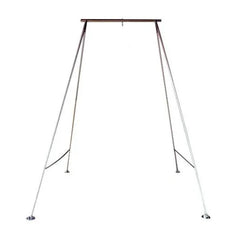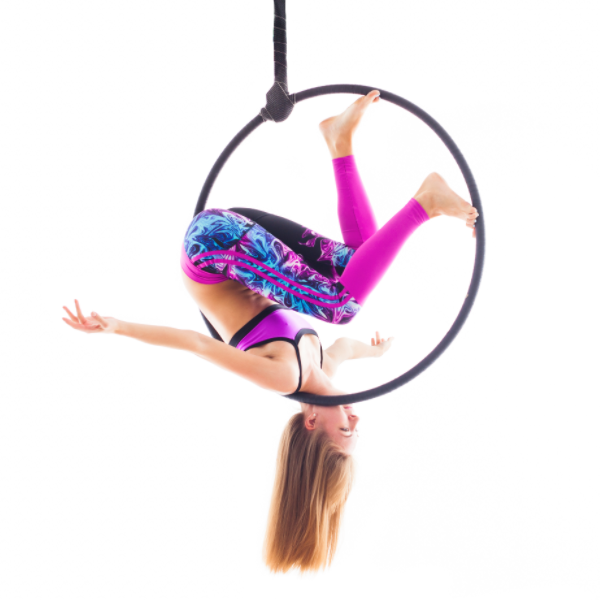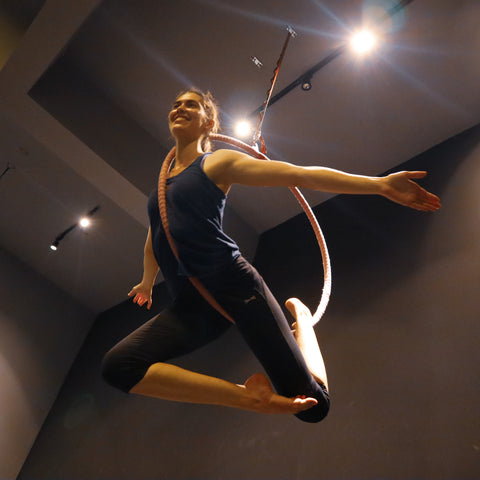The Lyra or aerial hoop is one of the most striking of all the aerial apparatuses thanks to its perfectly circular design. Because it creates such a perfect frame for the artist, the aerial ring, aka cerceaux, is highly flattering to the performer which makes it a great choice to start out on.
The Lyra or aerial hoop allows for a vast range of exercise from below, within, and above the bar. From conditioning exercises to flips, the Lyra provides a perfect circle through which to move the body, find new shapes, and challenge your potential.
The Lyra or aerial hoop is certainly one of the most romantic of the aerial apparatuses owing to its geometric design. However, don't let its prettiness fool you. The aerial ring can be extremely uncomfortable on the body. Over time most aerialists build up a tolerance to the pain.
Lyra Hoops History
Many aerial arts historians note that in the late 1800s, metal hoops were used for children’s play. Although the precise origin of the aerial hoop is difficult to verify, many aerial and circus historians agree that the first recorded aerial hoop performance was documented for an advertisement in the New York Clipper, a 19th-century entertainment newspaper.
At the time, it was one of the oldest theatrical journals in America. The paper featured vaudeville, burlesque, circus, and more.
In 1893, an artist named Caedo was featured in its pages perched on an aerial ring in an early display of the art form, debuting the apparatus in print. Now, Caedo’s performance is forever memorialized as a historical landmark of this now-beloved aerial apparatus.
Aerial hoop experienced a renaissance in the early 2000s with Cirque du Soleil’s wildly successful show Verakai. Inspiring countless artists across the globe, the aerial hoop is now a standard apparatus in aerial studios everywhere.
What are Lyra Hoops
The aerial hoop is an elegant ring made of steel or aluminum suspended from an overhead point upon which a performer can spin, swing, transition, and pose, demonstrating skills of great flexibility, strength, and grace.
Aerial hoop is a wonderful apparatus for all skill levels of the aerial arts, from the beginner to the seasoned professional. On it, you can work your power moves, perfect your scorpion, or just sit on the bar and pose like a bird. Because the apparatus has the ability to spin, your audience is privileged to a 360-degree view of your performance, a mesmerizing effect. The aerial hoop is also known as the Lyra or cerceaux.
Types of Lyras
Aerial hoops come in a variety of sizes and widths which are chosen depending on individual preference. There are single tab hoops, double tab hoops, and tabless hoops, which are described in detail later in this article.
Aerial hoops can be used with one or more performers, but it’s important to make sure your hoop is suitably rated if you plan to invite a friend onto it with you.
Where to buy Lyra Hoops
As the leaders in aerial equipment, Uplift Active offers a range of aerial hoops for sale to suit your fitness and performance needs. Find your perfect Lyra when you order from Uplift Active, and get top quality products along with access to our dedicated and expert support team.
We offer two aerial lyra hoops for sale in our online boutique:
- The Lightweight Stainless Steel Single Point Lyra Hoop is ideal for controlled spins, beautifully simple lines, and intricate choreography. Single point hoops are perfect for everyone from those just starting out to professionals. The hoop is hollow, light, and moves effortlessly with the performer. Lighter hoops also tend to leave less bruising. Available in both grip sizes, this hoop is perfect for performance, tricks, and drops. It comes in various sizes ranging from 31 inches to 41 inches.
- The Lightweight Stainless Steel Double Point Lyra is ideal for times when you want a little more stability in your hoop sessions. Perfect for the beginner to the professional, this hoop is great for tipping moves that are not possible on a single point Lyra. It's also available in two grip
- If you are interested in getting started with Lyra, or just want to update your equipment, then The Complete Lyra Hoop Kit is right for you. It comes with everything you need to rig your new hoop, including the hoop, carabiners, swivel, and round sling.

With Uplift Active, checkout is super easy and secure. We provide a 100% satisfaction guaranteed, or you will get your money back. Our incredible customer reviews are testimony to our commitment to the customer!
The Lyra provides a frame within which amazing things can happen, and the blend between exercise and art is endless with aerial acrobatics. The Lyra is beginner-friendly but you will take it with you throughout your journey in the air.
How to Choose the Perfect Aerial Hoop
Aerial hoop is a well-rounded part of any aerial practice, and it’s a natural progression from pole fitness, aerial yoga, and aerial silks… or the other way around. But however you get into your hoop, it’s important to choose the one that’s just right for you.
Aluminum and steel have disparate static and dynamic load dimensions. A static load is your standing or sitting weight while you’re on the apparatus. When you introduce movement, the static load becomes a dynamic load, exerting greater force onto the Lyra. Your dynamic load can measure up to 5 times your weight. Professional rigging is always critical for safety purposes.
As with any aerial apparatus, keep in mind how and where you’ll be using your hoop. Are you interested in supported inversions or lateral tipping on the hoop? A double tab Lyra may be the one for you. With more static options for movement above the bar, you’ll find greater stability as you move. However, double point hoops will take up more vertical space overhead with rigging.
Do you want to spin with great abandon, creating incredible shapes as you turn? A single tab Lyra is best for this, and these can be rigged in smaller areas. A single point aerial hoop offers the potential for more vocabulary in the air. You can also rig your double tab Lyra to a single point overhead to spin. If you want to rotate around the space in a circle manège style, you’ll need a large footprint on the floor.

Hollow vs Solid Aerial Lyra Hoop
Consider whether you’ll want a hollow steel or a solid bar yoga hoop. Hollow tubes are lighter and tend to spin with ease. A solid bar may be more of a challenge to spin, but its rotation will last longer once it accumulates momentum.
Your hoop size is its external diameter. You can determine which size is best for you by sitting upright in a chair, measuring the length from the base of the chair to the top of your head. Add 2 inches to this measurement, and you’ll know what size you need.
Also, consider your grip size. There is a 9mm difference in thickness between the 24.3mm and 34mm. If you are a gymnast or a pole dancer, or if you have larger hands, a wider grip may be preferable to you. The industry standard size is 25mm, while at 34mm is a little thicker. Those that are new to the work or those that have used pole previously may find the thicker grip easier to handle.
In addition to your aerial hoop, you’ll need some rigging equipment to get started. Many aerialists use round slings to suspend from overhead with carabiners as their point of connection. If you want to spin, you’ll also need a swivel.
The Benefits of Owning Your Own Aerial Hoop at home
There is a tipping point in aerial arts where one decides that it’s time to start collecting her own equipment in order to achieve greater freedom. Purchasing your gear for the first time may be intimidating, but it’s an investment in your career as an aerial artist that will give back for years and years down the line. In this way, owning your own Lyra actually saves you money.
After it pays for itself by way of your performance fees, class fees, or money saved at open gyms, it’s clear that having your own gear is incredibly cost-effective. You’ll control the wear and tear and you can use your hoop when you want. Even if you are just starting out, you can make incredible shapes in the Lyra that are not possible anywhere else.
Caring for Your Aerial Hoop
Some artists prefer a blank canvas while others use Mueller tape to wrap the metallic ring for improved grip. Some also like to use a small amount of rosin while working on their hoop while others prefer to rely on their natural grip.
Performing outside in the open air can be a wonderful experience, but make sure not to leave your Lyra outside. Store it in a bag made for aerial hoops when not in use.
If you are an entertainer, be sure to keep all of your aerial equipment -- and yourself -- safe during a performance. At no time should anyone be near you while you’re performing, and while you are not on the equipment, make sure it’s out of the way.

Rigging and Safety Education: Understanding the Basics
Safety should be your number one motivation when you will be hanging headfirst towards the floor. Make sure you source your aerial hula hoop from a reputable company that has weight tested their contraptions.
Consider where you plan to hang your Lyra. The equipment required may vary from space to space. If you have access to or own an aerial rig, the setup could be different than that at a professional or home studio, or a performance venue.
- Always follow your rig manufacturer’s recommendations. When in doubt, look up your questions, connect with a professional or ask a trusted rigger.
- Learn from a professional.
- Never exceed working loads for your hoop. Drops can be dyno tested to determine how much force they generate, so you don’t need to wonder.
- Never train alone.
- Check your rigging each time you use it. Be careful that the rigging point is high enough to have enough clearance.
- Store your equipment wisely.
- Use a crash mat for your training.
For additional reading material and safety training resources, check out ETCP rigging educators Delbert Hall and Brett Copes.
Tricks and Choreography
Aerial hoop is a wonderful creative movement practice whether you aim to get a great full-body workout or to entertain the masses. There is a world of beautiful sequences waiting to be discovered and invented, from simple and breathtaking poses within the hoop to aerial contortion to dynamic flips and dizzying spins. How you find your pathways through the hoop depends on your personal preference.
You can hang from your hoop from just about every extremity of your body, while inventive balances challenge and strengthen your muscles. Even just sitting inside the hoop’s perfectly circular frame makes a beautiful image whether you’re spinning or static. Aerial hoops are perfect for practicing gymnastics, cardio, strength training, and more.
The Best Lyra Hoop Workouts for Beginners
As a beginner, you will likely begin learning basic hangs from your hands to increase arm and grip strength. You can also hang from your elbows and armpits. Depending on the setup and your apparatus, you can spin, swing, or tip into daring inversions.
Knee hangs are usually taught early on in a Lyra artist’s career and can be executed with one or two knees. Start on the floor and hold on to the bar. tuck your knees up, and hook around the hoop. When you're ready to let go, extend! These will strengthen your abs and get you used to being inverted
The ankle hangs are more advanced moves and demand strong abdominals coupled with high pain tolerance. Don’t let that scare you though; anyone advancing in the aerial arts will be familiar with a little discomfort, and stepping out of that comfort zone is always worth it.
Elbow hangs are another simple move to begin with. Simply start on the floor and hook your elbow over the bar. Try supporting your body weight with just the elbow, and then introduce a spin. Don't forget the other side!
The Best Intermediate Lyra Hoop Workouts
Try Lyra sit-ups and Lyra pullups to build strength and endurance for a great intermediate workout! These will push your limits and create excellent stamina for your practice later.
From the floor, come to a simple knee hang, and then raise the body up as high as possible, reaching for the top bar. Do as many as you can!
Pullups on the aerial hoop are pretty straightforward. Try them from the floor and then from the top of the hoop!
The Best Advanced Lyra Hoop Workouts
The neck hang is another advanced movement on the hoop that offers a great reward once mastered. Always a crowd pleaser, this move showcases a beautiful shape as the performer dangles from only the muscles in her neck.
Along with hanging moves are elegant balances from your back or front, or side. These can be stand-alone poses or transitions in your routine. In any aerial sequence, think about how movements lend themselves seamlessly to the next. Part of the magic of choreography lies in its transitions.
Frequently Asked Questions
How do I find aerial classes near me?
Check the interwebs! Aerial studios have proliferated in the last decade.
Here is a resource to get you started:
Can I use my aerial hoop at home?
Yes, you can. But be sure you have done your research on safety and rigging protocols, use a mat, and never train alone.
Why should I do aerial lyra hoop?
Aerial hoop or Lyra offers a rare chance to get and stay fit, challenge your mind, and showcase your loveliness with one of the most beautiful art forms in the world today… all at the same time.
As a celebrated practice that’s offered at studios around the globe, you can join a community of artists who truly love their chosen form. Explore the limitless freedom of self-expression in the air!
What size aerial lyra hoop should I get?
The best way to measure the hoop diameter you’ll need is to sit upright in a chair and measure from the base of the chair to the top of your head. Add two inches, and this is the diameter best for you.
Is lyra hoop hard/a good workout?
Yes. Aerial arts are a full-body workout, which challenges strength, endurance, and flexibility. It will also help you face your fears!
What muscles are involved?
All of them! Aerial arts are a wonderful full-body and mind workout, so be sure to warm up accordingly.
Is aerial hoop dangerous?
Perhaps it can be said that life itself is dangerous. Aerial arts come with a certain degree of risk, but practicing safe rigging, technique, and a high degree of common sense will mitigate those factors. Always work with a qualified instructor and ask questions. Once you have covered all the bases, you have only your mind to conquer.

So what are you waiting for!
Aside from being one of the most inspiring performance art forms, the Lyra is also a constellation in the night sky. This configuration of stars in the northern sky represents the ancient stringed lyre instrument. It’s no wonder that aerial hoop is known as the Lyra, as its lyrical dance can move anyone to dream bigger.
If you are inspired to start an aerial hoop practice of your own, expand your studio, or collect your next apparatus, contact Uplift Active with any questions.





Leave a comment